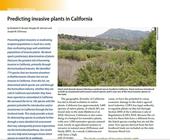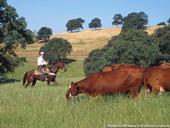- Author: Chris McDonald
I have had the pleasure to conduct a variety of experiments, watch numerous management talks and take many classes on the scientific method. During these adventures I've noticed that people seem to misunderstand (or not comprehend the full power of) replication.
Replication is the repetition or duplication of an experiment. On the surface this seems pretty straightforward; why would someone want to replicate or duplicate an experiment? They do it to double-check that the results are correct.
If I want to test to see if hummingbirds prefer red or yellow feeders, I can put out two colored feeders and count the number of visits. Great! Right? Not exactly.
The experiment...
- Author: Brad Hanson

Link to a recent (July 2014) research article in California Agriculture (link to table of contents for volume 68)
Brad
The article by E.D. Brusati, D.W. Johnson, and J.M. DiTomaso is entitled "Predicting Invasive Plants in...
- Author: Carl E. Bell
- Re-posted by: Gale Perez

From the Invasive Plants in Southern California blog :: Nov. 22, 2013
Hi All. In my last blog the subject was about what I had learned regarding the use herbicides as a tool for effective passive restoration of CSS and native grassland habitats. As an Extension Advisor my job is to not only develop new information, but to also try to move it forward into practice.
In this case that means educating land managers and related professionals on how to efficiently and accurately apply herbicides to large areas. That's what the Cooperative Mule is all about, so sit back, I hope...
- Author: Chris McDonald
I'm sure you've noticed that different years have dominant weed species. For example this year in Southern California Russian thistle (aka tumbleweed Salsola tragus among other Salsola species) is abundant in many areas. Other years it is only moderately abundant and some years it seems to hardly hang on. The obvious question is why? Why is there so much variation in abundance between years?
Fortunately for us people have been working on this issue for a while and have a few general answers for us. Since the bulk of weeds in California are annuals I'll limit my discussion to those plants.
The seeds of annuals germinate only under a certain range of environmental conditions....
- Author: Carl E. Bell
- Posted by: Gale Perez

Some tips on grazing for invasive plant control
Using livestock for controlling invasive plants has a lot of appeal; the animals seem like a natural, green method; they're cute; and at times they can be a very inexpensive way to do some weed control. But there are also various difficulties and issues with using livestock that should be understood before you jump into a grazing program, I've discussed some below.
Livestock have different eating preferences and needs; Cattle (photo of cattle courtesy of Jack Kelly Clark, UCANR) like grass, sheep like grass and forbs, goats like browse (foliage on stems of woody shrubs, young stems and bark, like photo), and horses like grass.
They eat...


